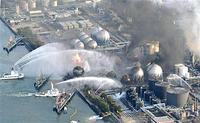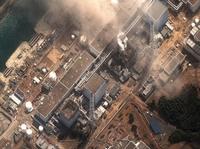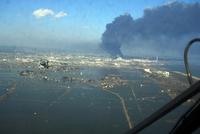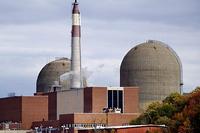-
Algae might help reduce nuclear waste
The humble algae — Closterium moniliferum — might one day soon be used to help separate strontium from calcium in nuclear waste; if successful, the process could lead to a reduction in the amount of nuclear waste that is left over from nuclear power facilities, and might even help in cleanup when accidents occur such as the one in Chernobyl, Ukraine, that spewed great quantities of strontium into the surrounding environment
-
-
Japan widens evacuation radius
Japanese officials have enlarged the evacuation zone around the Fukushima Daiichi power plant, as workers continue their struggle to repair the damaged nuclear reactors; last Friday a “voluntary evacuation” of people still living within nineteen miles of the plant was issued; residents within nineteen miles have remained indoors unable to leave their homes to purchase basic supplies and companies have refused to deliver; the voluntary evacuation could add an even greater strain to existing temporary shelters; currently 242,881 people are still living in shelters around the country and officials are struggling to provide enough basic supplies like food, water, and sanitary goods
-
-
Global nuclear bomb sensors used to track Japan's radiation
A worldwide network of radiation sensors originally built to detect nuclear weapon tests is now being used by scientists to track radiation leaked from Japan’s Fukushima Daiichi nuclear power plant; over 280 sensors were installed to detect radiation from nuclear weapons testing; the sensors have detected several radioactive elements that are the byproducts of nuclear fission like iodine-131 and cesium-137 from Japan; experts studying the data disagree on the effect and size of the release, but assure the public that the effects are minimal as much of the radiation is being scattered across the Pacific
-
-
Half of EPA's radiation warning system in California defective
The defective sensors are part of EPA’s RadNet detection system which was created to provide an active warning system that would alert scientists and public health officials of any elevated levels of radiation so they can warn the public or take other protective measures; half of California’s twelve sensors have been sending data with “anomalies” to the EPA’s main laboratory; the faulty data results in delays of up to several hours; officials say that the sensors are fully functional and that the delays are a result of “glitches” in satellite transmissions; there are several other radiation sensors in the United States operated by local, state, and federal agencies
-
-
Washington nuclear sensors capable of detecting faintest amounts of radiation
The radiation detectors developed by the Pacific Northwest National Laboratory (PNNL) in Washington are so sensitive that they can detect trace amounts of radioactive material from hundreds of thousands of miles away; far from being a public health concern, the amount of radiation from Japan detected on the west coast of the United States was far less than what individuals receive from natural sources and is testament to the sensors extraordinary sensitivity; officials say that the PNNL’s sensors are a hundred times more sensitive than other radiation sensors; the PNNL facility is capable of picking up the faintest amounts of radioactive elements produced by nuclear reactions from the vast amounts of air particles in the world
-
-
Countries closely monitor Japanese food for radiation
On Saturday, Japan announced that radiation was detected in spinach and milk produced near the Fukushima nuclear plant; the levels were low enough to not pose a long-term threat to human health, but they were above the national safety level, so the Japanese government has stopped sales of food products from near the damaged plant; countries importing food products from Japan are on alert
-
-
Nuclear crisis worsening; growing radiation leaks at reactors nos. 3, 4

The situation at the Fukushima Daiichi nuclear power plant appears increasingly dire, as efforts to cool overheating reactors have failed; Japanese military fire trucks are now spraying water at the plant’s no. 3 reactor; earlier efforts on Thursday to use helicopters to dump water on the rods have failed; the U.S. Nuclear Regulatory Commission chairman is particularly concerned about reactor no. 4 which houses spent fuel rods; spent fuel rods, placed in cooling tanks, are rapidly overheating as they are boiling away the water they are submerged in; the secondary containment unit at reactor no. 4 has been breached and radiation is now freely leaking out of the plant; high radiation levels are hindering efforts to repair the reactors
-
-
Japan's nuclear crisis increasingly dire

Japan’s ongoing nuclear saga took a decided turn for the worse on Tuesday when a third explosion at a nuclear reactor may have cracked the containment unit protecting it, causing large amounts of radiation to leak out; the government requested assistance from the IAEA on Tuesday and teams were dispatched to help monitor radiation and human health; citizens within a thirteen mile radius of the Fukushima Daiichi power plant were evacuated and 140,000 residents within a twenty mile radius have been advised to stay indoors; officials also established a twenty mile no-fly zone around the power plant; officials in Tokyo reported that radiation levels were ten times their normal levels; experts say that these increased exposure levels do not pose an immediate threat to people, but the long-term effect remains unknown; the Tokyo Electric Power Company is considering using helicopters to pour cold water on top of overheating rooftops covering spent fuel rods; a small crew of fifty technicians at the badly damaged power plant is bravely fighting through high radiation levels and fires to contain the three reactors
-
-
EU considering subjecting nuclear plants to stress tests
The EU is considering subjecting the 150 nuclear reactors operating in Europe to stress test to check their safety in light of Japan’s nuclear crisis; the EU’s executive arm has no power to send experts to nuclear plants to see whether they are safe, but can discuss stress tests to see if EU nations would authorize them
-
-
Nuclear terrorism is a preventable catastrophe
Graham Allison, a nuclear proliferation expert, warns of the seriousness of the threat of nuclear terrorism and the ease with which rogue states or terrorists groups can obtain weapons or fissile material and the knowledge essential to developing production capability; “The number of rogue states and terrorist groups seeking to acquire nuclear weapons is increasing. There are a number of states willing to sell it to anyone, and a larger number of sites where enriched weapons grade plutonium and uranium can be found in conditions where they might be vulnerable to theft due to lack of security,” he says
-
-
Californians anxious about safety of nuclear reactors

The parallels between Japan and California are sobering: As in Japan, California’s two plants — Diablo Canyon near San Luis Obispo and San Onofre in Southern California — sit in active earthquake zones; like Japan’s, both rest beside the ocean and were built more than a quarter-century ago; perhaps most troubling, the San Onofre plant straddles two counties in Southern California with a combined population of 6 million people
-
-
Official: U.S. safe from Japanese radiation

U.S nuclear officials said that there was very little chance that harmful levels of radiation from Japan’s nuclear reactors would reach Hawaii or the west coast of the United States; the head of the Nuclear Regulatory Commission (NRC) also said nuclear plants in the United States were designed to withstand natural disasters like earthquakes and tsunamis; readings from radiation sensors placed on the west coast have not detected any increases in radiation levels and experts do not expect any increases; Japanese utilities have flooded two nuclear reactors with sea water in a desperate attempt to cool them down and prevent a meltdown; the NRC has dispatched two nuclear experts to Japan to assist with efforts to keep three damaged reactors from melting down
-
-
Future of U.S. nuclear plans uncertain after Japanese nuclear crisis

As Japan continues its struggle to control its nuclear reactors, the future of the U.S. nuclear industry has become increasingly uncertain; nuclear power had emerged as the bipartisan solution to easing America’s dependency on oil; in February 2010, President Obama announced $8.3 billion in loan guarantees to energy companies to build the first new nuclear power plants in the United States in almost thirty years; some lawmakers have called for a moratorium and stricter safety regulations, while others are urging for a more measured response; Energy Secretary Stephen Chu and Gregory B. Jaczko, the chairman of the Nuclear Regulatory Commission, will testify before the House Energy and Commerce committee on Wednesday
-
-
New .gov threat detection software nearing completion
DHS is currently in the final stages of implementing Einstein 2, its new cybersecurity threat detection system, across all federal networks; Einstein 2 is designed to provide the government with intrusion detection tools on its networks; installation is expected to be completed this year; DHS is also in the midst of testing Einstein 3 and hopes to begin installation of that system within the year; the Einstein system is part of a total suite of technological solutions designed to secure the .gov domain from cyber threats; these tools are being developed in conjunction with the Department of Defense
-
-
Helium-3 shortage endangers nuclear detection capabilities
Demand for radiation detectors has surged as a result of increased efforts to stop nuclear proliferation and terrorism, but production of helium-3, a critical element in nuclear detection technology, has not kept pace and existing stockpiles are quickly dwindling; in 2010 demand for helium-3 was projected to be 76,000 liters per year; the United States only produces 8,000 liters of helum-3 a year; last year the U.S. stockpile of helium-3 was at less than 48,000 liters; alternatives are currently in the early stages of development and researchers have found several promising leads; when an alternative is found, current radiation detection equipment will have to be replaced with the new technology
-
- All
- Regional
- Water
- Biometrics
- Borders/Immig
- Business
- Cybersecurity
- Detection
- Disasters
- Government
- Infrastructure
- International
- Public health
- Public Safety
- Communication interoperabillity
- Emergency services
- Emergency medical services
- Fire
- First response
- IEDs
- Law Enforcement
- Law Enforcement Technology
- Military technology
- Nonlethal weapons
- Nuclear weapons
- Personal protection equipment
- Police
- Notification /alert systems
- Situational awareness
- Weapons systems
- Sci-Tech
- Sector Reports
- Surveillance
- Transportation
Advertising & Marketing: advertise@newswirepubs.com
Editorial: editor@newswirepubs.com
General: info@newswirepubs.com
2010-2011 © News Wire Publications, LLC News Wire Publications, LLC
220 Old Country Road | Suite 200 | Mineola | New York | 11501
Permissions and Policies
Editorial: editor@newswirepubs.com
General: info@newswirepubs.com
2010-2011 © News Wire Publications, LLC News Wire Publications, LLC
220 Old Country Road | Suite 200 | Mineola | New York | 11501
Permissions and Policies
